10 Best Machine Learning Ops Strategies for Cloud Environments in 2024

The year 2024 looms on the horizon, promising exciting advancements in the realm of Machine Learning (ML). As Machine Learning models become increasingly complex and ubiquitous, deploying and managing them efficiently in cloud environments has become crucial. This is where Machine Learning Ops Strategies comes in, streamlining the ML lifecycle from development to deployment and beyond.
Talking about Machine Learning Ops Strategies (MLOps), these are a set of practices and tools that streamline the management, deployment, and monitoring of machine learning models in cloud environments. Think of it as the “operations” side of machine learning, similar to how DevOps manages software applications.
Here is a breakdown of the key components
Machine Learning (ML): This refers to the algorithms and models that learn from data and make predictions or decisions.
Operations (Ops): This encompasses the processes and tools used to automate and manage the lifecycle of a system, ensuring its efficiency and stability.
Strategies: These are the specific approaches and best practices used to implement MLOps effectively.
Here are the 10 best Machine Learning Ops strategies for cloud environments:
Organize Your Project Well
Start by arranging your code in a tidy structure with consistent naming and file formats. Create clear guidelines for workflows, code reviews, and version control to enhance collaboration. Document these guidelines for easy accessibility and adherence by all team members. You can use project management solutions for better project organization.
Choose ML Tools Wisely
Before choosing machine learning (ML) tools, it’s crucial to have a clear understanding of your project requirements. This involves assessing the nature of the data you’ll be working with, the complexity of the ML models you intend to develop, and any specific performance or scalability needs. Consider factors such as ease of use, community support, documentation quality, and compatibility with your existing infrastructure. You can experiment with multiple tools to determine the one that aligns best with your project’s unique needs. In the process of selecting ML tools, it’s essential to ensure compatibility with your existing systems and seamless integration with other tools in your technology stack. This strategic approach minimizes potential bottlenecks and guarantees a smooth workflow throughout your entire ML pipeline.
Automate All Processes

Automation plays a pivotal role in optimizing the machine learning (ML) pipeline. By automating data preprocessing, cleaning, and transformation, the workflow becomes more efficient, saving time and ensuring consistency. Streamlining ML model training and deployment through automation not only enhances reproducibility but also significantly reduces the manual effort required in the development process. Prioritizing automation of hyperparameter tuning and deployment further accelerates model iteration speed, allowing for swift experimentation and refinement. In essence, automation empowers practitioners to focus on refining models and driving innovation, ultimately improving the overall efficiency of the ML workflow.
Encourage Experimentation and Tracking
Encourage trying out various algorithms and features to create an environment where experimentation is valued. Set up systems to keep track of experiment details, such as parameters and results, making it easy for the team to collaborate and reproduce successful approaches. Sharing experiment results within the team not only fosters collaboration but also speeds up the development of models.
Adapt to Organizational Change
Stay updated on the latest ML developments and encourage continuous learning. Be open to adapting project priorities, goals, and workflows as needed. Foster a collaborative environment for effective communication and problem-solving across teams.
Ensure Reproducibility
Implement version control for code, data, and model configurations. Use containerization technologies like Docker for consistent model execution across different environments. Regularly commit code and data changes with descriptive messages to track project history.
Validate Data Sets

Perform data quality checks to ensure accuracy, completeness, and relevance. Split data sets into training, validation, and testing sets to prevent overfitting. Use appropriate techniques, like stratified sampling, to maintain data representation.
Monitor Expenses
Monitor resource usage, including CPU, memory, network traffic, and storage. Optimize resource allocation using auto-scaling, resource pooling, and workload optimization. Consider using cloud services for cost-effective and scalable infrastructure.
Evaluate MLOps Maturity
Periodically assess MLOps maturity using established models. Set measurable goals based on the assessment to guide continuous improvement. Communicate goals to the team and stakeholders for alignment and shared understanding.
Implement Continuous Monitoring and Testing
Continuously monitor ML model performance metrics in production environments. Regularly test the entire ML pipeline, including data processing, training, deployment, and maintenance. Implement automated remediation processes to address issues promptly and minimize downtime.
How ESDS Helps You Implement MLOps Strategies
ESDS, a leading cloud service provider in India, understands the critical role of MLOps in today’s AI-driven landscape. The company offers a comprehensive suite of MLOps solutions, including:
Managed Cloud Platforms: Pre-configured cloud environments optimized for MLOps workflows, with built-in tools and services like Kubernetes, CI/CD pipelines, and monitoring dashboards.
Expert MLOps Consulting: ESDS’ team of MLOps specialists can help you design, implement, and optimize your MLOps strategy based on your specific needs and cloud environment.
By partnering with ESDS, you can leverage expertise and infrastructure to implement these MLOps strategies effectively and unlock the full potential of your ML models in the cloud.
Embrace these strategies, partner with the right cloud provider like ESDS, and propel your ML initiatives to new heights in 2024 and beyond!
- Decoding Generative AI: A Comprehensive Guide to Gartner’s Impact Radar - January 2, 2024
- 5 Best Practices for Cloud Security in 2024 - December 29, 2023
- 10 Best Machine Learning Ops Strategies for Cloud Environments in 2024 - December 29, 2023
